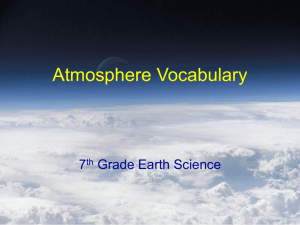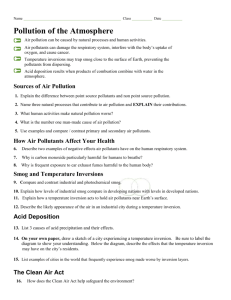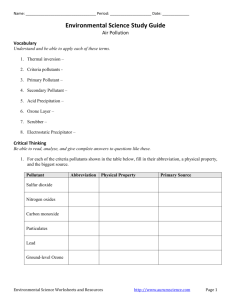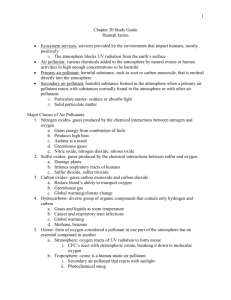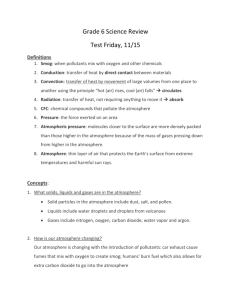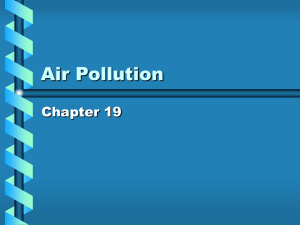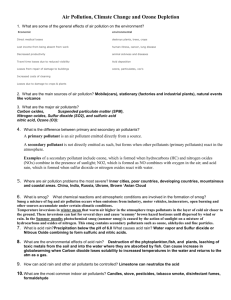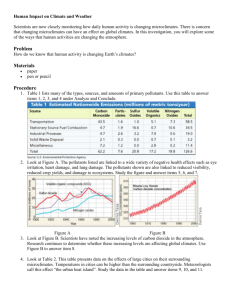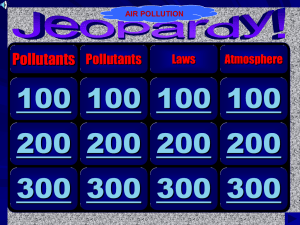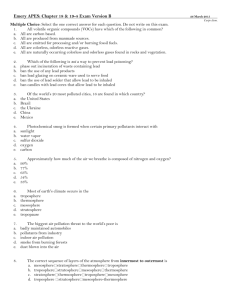H1_Activity_Title - Mr. Chang`s and Ms. Aguiles` Environmental
advertisement
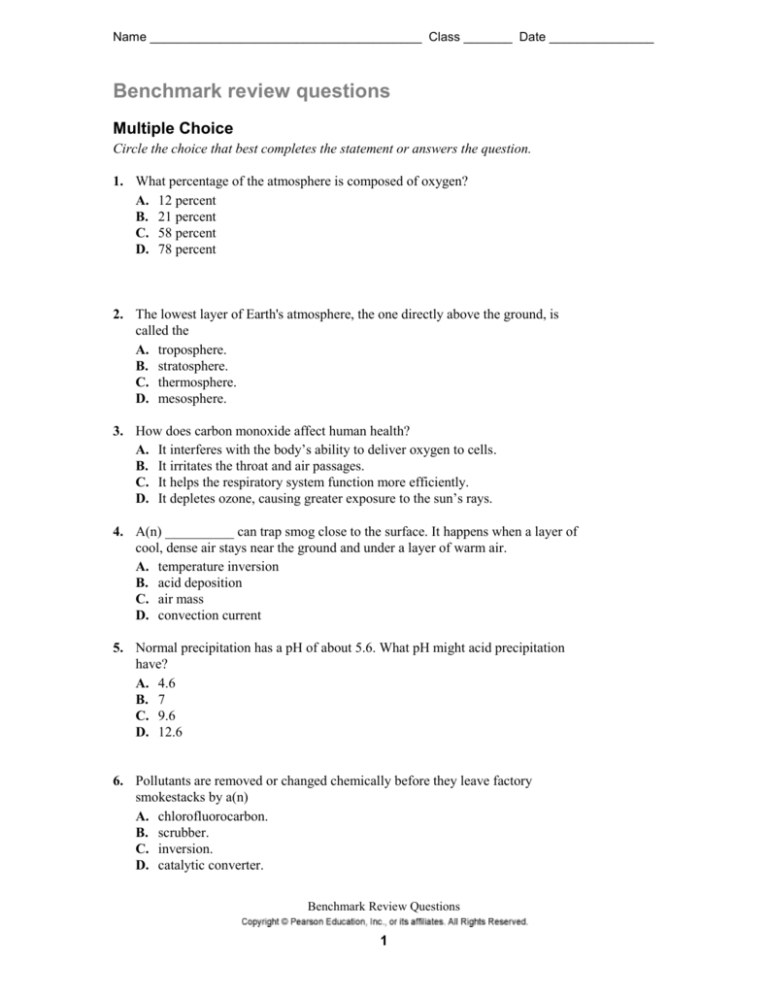
Name _______________________________________ Class _______ Date _______________ Benchmark review questions Multiple Choice Circle the choice that best completes the statement or answers the question. 1. What percentage of the atmosphere is composed of oxygen? A. 12 percent B. 21 percent C. 58 percent D. 78 percent 2. The lowest layer of Earth's atmosphere, the one directly above the ground, is called the A. troposphere. B. stratosphere. C. thermosphere. D. mesosphere. 3. How does carbon monoxide affect human health? A. It interferes with the body’s ability to deliver oxygen to cells. B. It irritates the throat and air passages. C. It helps the respiratory system function more efficiently. D. It depletes ozone, causing greater exposure to the sun’s rays. 4. A(n) __________ can trap smog close to the surface. It happens when a layer of cool, dense air stays near the ground and under a layer of warm air. A. temperature inversion B. acid deposition C. air mass D. convection current 5. Normal precipitation has a pH of about 5.6. What pH might acid precipitation have? A. 4.6 B. 7 C. 9.6 D. 12.6 6. Pollutants are removed or changed chemically before they leave factory smokestacks by a(n) A. chlorofluorocarbon. B. scrubber. C. inversion. D. catalytic converter. Benchmark Review Questions 1 Name _______________________________________ Class _______ Date _______________ 7. Ozone depletion was caused by the following chemicals, which were used in refrigerators and aerosol spray cans. A. catalytic converters B. fossil fuels C. chlorofluorocarbons D. scrubbers Modified True/False Indicate whether the statement is true or false. If false, change the identified word or phrase to make the statement true. __________________ 11. In general, warm air can hold less water vapor than cooler air. __________________ 12. The ozone layer is found within the troposphere. __________________ 13. Primary pollutants are produced when air pollutants react chemically with other substances. __________________ 14. Trace amounts of some air pollutants may contribute to cancer. __________________ 15. As a result of the Clean Air Act, today, gasoline used by cars and trucks in the U.S. contains very large quantities of lead. How do plants affect the atmoshpere? Two way traffic of carbon dioxide and oxygen occurs with plants. Plants take in CO2 and release 02. Metamorphic rock- when rock is exposed to great heat and pressure. Igneous- magma cooling and solidifyin Sedimentary rock- rock exposed to wind, rain, ice that strip away grains and chunks of rock p. 396 layers of sediment build of time. If building something to hold water what would you use: Clay, loam, some rocks. 5 parts of the atmosphere: Troposphere, stratosphere, mesosphere thermosphere, p457 What does the atmosphere contain: Oxygen, Nitrogen, water.. Environmental Science • Chapter 15 Test A 2 Name _______________________________________ Class _______ Date _______________ Effect of O3 What is temp inversion: condition tin the trophoshpere that a layer of cooler air under warmer air that traps pollutants like smog. 3 Characteristics of of H20- three phases of water , solid, liquid, gas. Cohesive property of water Formation Sedimentary rock- rock exposed to wind, rain, ice that strip away grains and chunks of rock p. 396 layers of sediment build of time. What do the layers of the atm containAr, Kr, Oxygen, helium, neon, Co2 What is temp inversion: condition tin the trophoshpere that a layer of cooler air under warmer air that traps pollutants like smog. How to test exp of fertilizer: Vary the amount of fertilizer on the plants starting with zero. How does a wastewater treatment plant work: Prelim-trash, Prim-oil, Secondary- dissolved solids, treatment of solids Environmental Science • Chapter 15 Test A 3 Name _______________________________________ Class _______ Date _______________ Conduction- transfer of heat directly between 2 objects in contact w ea other Convection- transfer of heat in a fluid as warm parts of the fluid rise from the heat source and expand. Radiation- transfer of energy through space Fusion- the process of joining two 2 or mor things together. Environmental Science • Chapter 15 Test A 4 Name _______________________________________ Class _______ Date _______________ Completion Complete each statement on the line provided. 16. ____________________ is the force exerted by air on the area below it. 17. ____________________ describes the pattern of atmospheric conditions in large geographic regions over long periods of time. 18. If you combine the words smoke and fog, you get the word ____________________. 19. The acids that form from pollution in the atmosphere then settle to the surface of Earth are called acid ____________________. 20. The term ____________________ was used to describe the area of lowered ozone concentration over Antarctica. Short Answer Write the answers to the questions on the lines provided. 21. List the four main layers of the atmosphere, from lowest to highest altitude. __________________________________________________________________________ __________________________________________________________________________ __________________________________________________________________________ 22. Based on what you learned about radiation, describe what you could do to prevent your home from heating up so much as a result of radiation from the sun, and explain why it would work. __________________________________________________________________________ __________________________________________________________________________ __________________________________________________________________________ 23. During which season would you expect cold fronts to occur? __________________________________________________________________________ __________________________________________________________________________ __________________________________________________________________________ 24. Describe two of the effects of acid deposition. __________________________________________________________________________ __________________________________________________________________________ __________________________________________________________________________ __________________________________________________________________________ Environmental Science • Chapter 15 Test A 5 Name _______________________________________ Class _______ Date _______________ 25. Was the Montreal Protocol a success? Explain. __________________________________________________________________________ __________________________________________________________________________ __________________________________________________________________________ Other Use the illustration to answer the following questions. 26. Identify one part of the picture that illustrates conduction. __________________________________________________________________________ 27. What type of heat transfer is marked by letter C? __________________________________________________________________________ 28. Which letter represents the type of heat transfer that is primarily responsible for creating winds? __________________________________________________________________________ 29. Which letter represents a type of heat transfer that does not require direct contact? __________________________________________________________________________ 30. Which main layer of the atmosphere is depicted in this diagram? __________________________________________________________________________ Environmental Science • Chapter 15 Test A 6 Name _______________________________________ Class _______ Date _______________ Essay Write the answer to each question in the space provided. 31. Compare and contrast warm fronts and cold fronts and their effects. __________________________________________________________________________ __________________________________________________________________________ __________________________________________________________________________ __________________________________________________________________________ __________________________________________________________________________ __________________________________________________________________________ __________________________________________________________________________ __________________________________________________________________________ __________________________________________________________________________ __________________________________________________________________________ __________________________________________________________________________ __________________________________________________________________________ __________________________________________________________________________ 32. Describe an example of how a natural process can make air pollution caused by humans even worse, and also describe an example of how human activities can make natural air pollution worse. __________________________________________________________________________ __________________________________________________________________________ __________________________________________________________________________ __________________________________________________________________________ __________________________________________________________________________ __________________________________________________________________________ __________________________________________________________________________ __________________________________________________________________________ __________________________________________________________________________ __________________________________________________________________________ __________________________________________________________________________ __________________________________________________________________________ __________________________________________________________________________ __________________________________________________________________________ __________________________________________________________________________ Environmental Science • Chapter 15 Test A 7 Name _______________________________________ Class _______ Date _______________ 33. Compare and contrast primary and secondary air pollutants. __________________________________________________________________________ __________________________________________________________________________ __________________________________________________________________________ __________________________________________________________________________ __________________________________________________________________________ __________________________________________________________________________ __________________________________________________________________________ __________________________________________________________________________ __________________________________________________________________________ __________________________________________________________________________ __________________________________________________________________________ __________________________________________________________________________ __________________________________________________________________________ __________________________________________________________________________ 34. Explain how a temperature inversion differs from normal tropospheric conditions and how air pollution reacts differently in the two situations. __________________________________________________________________________ __________________________________________________________________________ __________________________________________________________________________ __________________________________________________________________________ __________________________________________________________________________ __________________________________________________________________________ __________________________________________________________________________ __________________________________________________________________________ __________________________________________________________________________ __________________________________________________________________________ __________________________________________________________________________ __________________________________________________________________________ __________________________________________________________________________ __________________________________________________________________________ __________________________________________________________________________ __________________________________________________________________________ Environmental Science • Chapter 15 Test A 8 Name _______________________________________ Class _______ Date _______________ 35. Has the Clean Air Act been a success? Explain. __________________________________________________________________________ __________________________________________________________________________ __________________________________________________________________________ __________________________________________________________________________ __________________________________________________________________________ __________________________________________________________________________ __________________________________________________________________________ __________________________________________________________________________ __________________________________________________________________________ __________________________________________________________________________ __________________________________________________________________________ __________________________________________________________________________ __________________________________________________________________________ __________________________________________________________________________ __________________________________________________________________________ Environmental Science • Chapter 15 Test A 9
